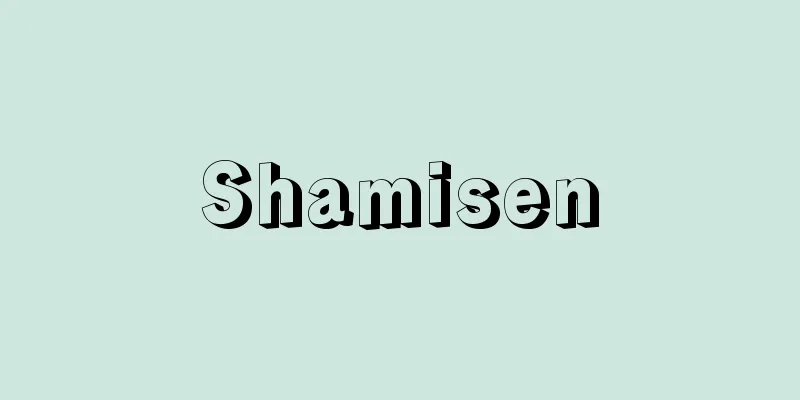Shamisen

|
A Japanese stringed instrument (a long-necked, plucked stringed instrument of the lute family). It is said to have originated from the Chinese sangen (three-stringed instrument), and was brought to Sakai, Quanzhou (Osaka) via the Ryukyu Islands in the late 16th century. After its introduction, it spread rapidly and was improved upon to become a representative instrument of early modern Japanese music to this day. The name "samisen" is thought to be a corrupted version of the Chinese pronunciation of "sangen" that was introduced to Japan. It is also common to pronounce sangen as it is, using the on-reading pronunciation, as "sangen." [Takanori Fujita] structureAlthough each shamisen has its own unique characteristics depending on the type and style, they all share the same basic structure and their overall length is roughly constant at around 97 centimeters. The neck is made of rosewood or rosewood; those made from a single piece of wood are called nobezao (extended neck), and those that can be disassembled when not in use are called tsugizao (jointed neck). The neck is fixed by passing it through the wooden frame of the body. At the top of the neck is a curved part called ebi-o (shrimp tail). Ebi-o has a space called itogura (thread storehouse) where the spools are inserted. Three silk threads of different thicknesses wound around the spools pass over a metal or bamboo kamigoma (top string) at the end of the itogura and are stretched over the neck. However, the bass string (ichi no ito), which is at the top when the player is in position, is removed from the kamigoma so that it is easier to touch the body of the neck. This technique is called sawari (sahari) and is not found in Chinese or Ryukyu samisen. By creating grooves on the neck parallel to the nut, slight undulations (mountains and valleys) are created, and when the first string vibrates, it touches the mountain, creating the effect of a subtle blending of different pitches. Making use of this effect is called "sawari ga tsuku" (a transition between two tones), and is important in terms of playing technique. The surface of the neck is otherwise flat and has no frets, but in the case of a tsukuchi, the joints in the neck serve as guides for fingering. The body is made of four boards of a hard material such as quince, assembled into a frame, with cat (or dog) skin attached to both sides. When playing, a bridge (shimogoma) is placed between the body skin and the strings. This determines the length of the vibrating strings at the bottom, and transmits the vibrations of the strings to the body skin. The bridge is made of hard materials such as ivory, tortoiseshell, or wood. Part of the neck protrudes from the bottom end of the body (nakagosaki), and a neo (string) is attached to it for tying the strings to it. The use of a plectrum (bachi) is thought to be influenced by the biwa (Japanese lute). The shape of the plectrum is almost the same for shamisen, but the size and material vary greatly depending on the type of instrument. The main materials used are ivory, tortoiseshell, and boxwood. As a rule, plectrums are not used in kouta (Japanese folk song), and instead, tsumabiki (a type of plectrum with a finger pick) is used. [Takanori Fujita] kindsUsually, shamisen are divided into three types according to the width of the neck: thick neck, medium neck, and thin neck. Thick necks are used for Gidayu-bushi, Tsugaru shamisen, and rokyoku (Naniwa-bushi), medium necks are used for Tokiwazu-bushi, Kiyomoto-bushi, Shinnai-bushi, and jiuta, and thin necks are used for Nagauta, Ogie-bushi, and kouta. However, even if they have the same thick neck, the details such as the size of the body and the material of the skin vary depending on the style and school, so these three classifications are very rough. It would be more accurate to classify shamisen according to the style and school. The plectrum (bachi) also differs depending on the style and school. Gidayubushi plectrums are heavy and large with a thick tip and a small opening on the outside. In Jiuta, Tsuyamabachi, which have a large opening and a thin tip, are preferred. In contrast, Nagauta plectrums are a size smaller. In Shinnai Uwajoshi, there are even smaller plectrums that are held and handled with the fingers. In Satsuma (Kagoshima Prefecture), a type of shamisen made of cedar boards called "gottan" was popular until recently. [Takanori Fujita] TuningThe tuning of the shamisen is determined not by absolute pitch, but by the relative pitch relationship between the strings. Each tuning is called a "choshi" (tune), and the basic ones are honchoshi (hon-choshi), niagari (ni-agari), and san-sagari (san-sagari), and derivative ones include ichi-sagari (ichi-sagari), roku-sagari (roku-sagari), ichi-agari (ichi-agari), niagari san-meri (ni-agari san-meri), etc. In Honchoshi, the Ni no ito is tuned a perfect fourth above the Ni no ito, and the San no ito a perfect fifth above the Ni no ito. Each tuning is named based on Honchoshi. Ni-agari is made by raising the Ni no ito of Honchoshi by a major second. San-sagari is made by lowering the San no ito of Honchoshi by a major second. However, actual tuning is not always done using Honchoshi as an intermediary. For example, when changing from San-sagari to Ni-agari in a piece, the tuning is changed by lowering the Ichi no ito by a major second, so the idea of fixing the Ichi no ito as the central note does not work. It is said that the key is strongly linked to the mood of the piece. Honchoshi is associated with authenticity and masculinity, Niagari with irregularity, showiness, and cheerfulness, and Misagari with femininity, grace, and sadness, and the choice of key is an important decision at the composition stage. When the mood of a piece changes within a piece, the key often changes as well. Derived keys are often used partially within a piece to change the tone and melody. Key changes during a piece are usually made instantly by manipulating the tuning pegs with the left hand without interrupting the performance. [Takanori Fujita] Playing techniqueThe basic stance for playing the shamisen is to sit upright, with the body placed on the right knee, and the right arm pressing down on the upper part of the body to stabilize the body. At this time, the left hand is lightly placed on the neck, but the neck should not be supported. The string is plucked by striking the tip of the plectrum diagonally down from above the strings. The plectrum that is struck down hits the bachikawa attached to the skin closest to the neck, producing a bachi sound. The bachi sound is valued for its percussion-like timbre effect. In Gidayu-bushi, there are many expressive techniques that adjust the strength of the bachi sound. There are also cases, such as jiuta, where the bachi sound is avoided and only the string sound is aimed for. A typical right-hand technique is the sukuibachi. Sukuibachi is a technique in which the strings are picked up and plucked, which produces a smaller sound but a different tone than normal plucking. This technique is often used in a pattern in which the strings are picked up after being struck down, and the action is repeated several times. The main role of the left hand is to press the strings on the neck and give them the required pitch. The strings are mainly pressed with the index finger, and the middle and ring fingers (and occasionally the thumb) are used as necessary for the progression of the melody. There are no frets on the neck, but there are certain positions where the correct pitch can be obtained, called kandokoro (or tsubo ). The left hand is required to accurately grasp the kandokoro, press the strings as if rubbing them against the neck to create vibrato, and move quickly from kandokoro to kandokoro. These actions require skill that can be performed without the aid of sight. In addition, in order to create a sawari for the first string, the kandokoro above the second and third strings, which are the overtones of the first string, must be particularly accurately pressed. Creating a sawari resonance is an important evaluation criterion for expression. In particular, in the Niagari tuning, if the sawari is not created, the sound produced by the resonance will not be as vivid and gorgeous, and the performance will not be good. Representative left-hand techniques include suri, in which the finger is moved along the strings to create a portamento effect; uchi, in which the finger strikes the strings down on the neck to produce a clear beat with a small sound; keshi, in which the strings are struck while shouting to end the reverberation; and hajiki, in which the finger is hooked around the strings and pressed down against the neck before releasing it. [Takanori Fujita] Notation and mouth shamisenWhen the shamisen was first introduced to Japan, musical notation was not used to transmit its performance, but rather it is believed that the expedient method of memorizing the melody by matching the instrument's sounds to the syllables of the words. Later, in an attempt to establish a more rigorous method of transmission, the Shichikushoshinshu was published in 1664 (Kanbun 4). This book presented a system in which each sound determined by the kansho and the right hand playing technique was displayed in a different kana. This standardized the way to recite the melody, and at the same time, efforts were made to write down the melody. However, because there are so many kana characters used, it is difficult to actually recite. Also, as the melody becomes more patterned, there is no longer any need to clearly distinguish each sound with a different kana. The "Voice of the Threads," or mouth shamisen, which was created around this time, is recorded in "Onusa," published in 1685 (Jokyo 2), and "Joruri Shamisen Solo Training," published in 1757 (Horeki 7). Mouth shamisen is a melodic singing technique that is still used today, and it clearly expresses rhythm through chanting and has the function of clearly indicating differences in playing style and tone with kana. The number of kana used is small, and pitch and key points are not indicated. However, the grouping of kana into phrases makes it easier to remember the melody and helps to recognize it as a pattern. Efforts were also made to develop the notation method itself. In Gidayu-bushi, the kana characters of the Iroha were assigned to the key points, and a writing style was established in which vermilion was written to the right of the words in the narration practice book. In Jiuta, an attempt was made to symbolize the rhythm, playing technique, and key points in detail in the Ongyokuchikaragusa (1762, 12th year of the Horeki era). The Gosenroku (1793, 5th year of the Kansei era) is a practical score that focuses on the mouth shamisen, with key point symbols and meter symbols added as necessary. The Genkyoku Taishinsho (1828, 11th year of the Bunsei era) uses the twelve rhythms to strictly notate the shamisen and song pitches, and also has ingenious meter notations. An attempt to document the steps of playing techniques can already be seen in the Oonusa, but it was difficult to put into practical use. In the Meiji period, attempts were made to convert shamisen music into musical notation, such as the Kojuro-fu (Kensei-kai-fu) by Yoshizumi Kojuro and its application, the Aoyagi-fu. In the Taisho period, various notation methods were devised, such as the Bunka-fu by Kineya Yashichi IV and the Fukuoka Dai-Nippon Kateigaku-Kai (Great Japan Home Music Association) which published home-style shamisen notation. Other notation methods include the O-satsuma abbreviated notation by Negishi Kangoro (Kineya Rokuzaemon XI) and the shamisen shorthand notation by Tanaka Shohei. [Takanori Fujita] Shamisen MusicWhen the shamisen was first introduced to Japan, it was used to play popular songs along with the koto, hitoyogiri shakuhachi, and other instruments, but from the mid-17th century, blind musicians began to compose shamisen kumika (group songs). Later, the koto and kokyu (or shakuhachi) were added to create sankyoku ensemble, and this tradition led to the establishment of jiuta. Joruri was originally a musical piece that told tales using the biwa, but it developed rapidly after the shamisen was adopted as an accompanying instrument in the early 17th century. At first, Joruri pieces such as Sekkyo-bushi, Kinpira-bushi, and Harimabushi were used in puppet theater, but during the Genroku period (1688-1704), Takemoto Gidayu brought together various schools of Joruri and established Gidayu-bushi. Gidayu-bushi is the representative form of puppet theater and is now the central music of Bunraku. Meanwhile, Kabuki also absorbed various forms of Joruri that had developed in the early 18th century, such as Itchu-bushi, Osatsuma-bushi, and Katou-bushi. Among these, Bungo-bushi, which was born from Itchu-bushi, became extremely popular, but was banned on the grounds that it was corrupting public morals, and it branched off. Tokiwazu-bushi and Kiyomoto-bushi remain as Kabuki music, and Shinnai-bushi was established as zashiki-joruri. Nagauta was created by musicians attached to Kabuki theaters, and in addition to being used as accompaniment and sound effects in the background, it also became established as a form of highly technical zashiki music, and continues to be used to this day. At the end of the Edo period, short songs accompanied by shamisen became popular and came to be called hauta or utazawa. In the Meiji period, similar short songs also became popular and have continued to be known as kouta to this day. Other popular forms of music during the Meiji period included folk songs sung to the accompaniment of the shamisen, rakugo, and female gidayu. Icchu-bushi, Miyazono-bushi, Ogie-bushi, and Kawato-bushi were also revived, ushering in a heyday for shamisen music. The current important genres are as follows: (1) Jiuta, (2) Nagauta, (3) Ogie-bushi, (4) Yamada-ryu Sokyoku (an ensemble of So and Shamisen), (5) Small songs - Hatsuuta, Utazawa, Kouta, (6) Joruri - Gidayu-bushi, Itchu-bushi, Kawato-bushi, Miyazono-bushi, Shinnai-bushi, Tokiwazu-bushi, Tomimoto-bushi, Kiyomoto-bushi, Rokyoku, (7) Folk songs and regional performing arts, and (8) Modern Japanese music such as New Japan Music. The shamisen music mentioned above is conveniently divided into songs (utaimono) and storytelling (katarimono). Songs include jiuta, nagauta, Ogie-bushi, hauta, and other small songs, as well as folk songs, while storytelling includes joruri such as gidayubushi, itchu-bushi, and rokyoku. Because this classification is widespread, the shamisen is often seen as an instrument that accompanies singing and narration, but when it comes to the progression of the song, the shamisen player often takes the lead rather than the singer or narrator. Even when playing and singing alone, the shamisen melody is the model for the learning process. Songs and narration are improved in technique and aesthetics as a deviation from the shamisen melody. Aikata in Nagauta and tegoto in Jiuta are instrumental performance sections inserted into a piece to showcase the technique of the shamisen itself. Aikata have their own names, such as "kinuta no akekata," "tsukuda no akekata," and "gaku no akekata," and their expressive styles have become sophisticated, quoting musical patterns that symbolize specific atmospheres from other genres of music and imitating natural sounds. Tegoto developed into an instrumental ensemble section independent of vocal music, with the stylization of "interactions" with the shakuhachi and koto, and heterophonic sound structures. In addition, the short solo sections placed between songs and narration are called ai-no-te, and they have the role of pushing the song forward with frequent use of calls and other chants; they can be seen in all types of dance. [Takanori Fujita] "The Society for the Study of Oriental Music, ed., Oriental Music Selection 7: Shamisen and its Music" (1978, Ongaku No Tomosha) [References] | | | | | | |©Shogakukan "> Names of the different parts of the shamisen [Left] Nagauta shamisen, thin neck [Center] Kouta shamisen, medium neck [Right] Tsugaru shamisen, thick neck ©Shogakukan "> Types of Shamisen From the left, bachi used in Gidayu, Tokiwazu, Kiyomoto, Shinnai, Nagauta, folk songs, enka, and zokukyoku, Tsugaru shamisen, and Shinnai nagashi . ©Shogakukan Types of shamisen plectrums From the left, pieces used in Gidayu, Tokiwazu, Kiyomoto, Shinnai, Kouta, Nagauta, Minyo, Tsugaru shamisen, and Jiuta . ©Shogakukan Types of shamisen bridges ©Shogakukan "> Tuning the shamisen Source: Shogakukan Encyclopedia Nipponica About Encyclopedia Nipponica Information | Legend |
|
日本の弦鳴楽器の一つ(リュート属長頸撥弦(ちょうけいはつげん)楽器)。中国の三絃(さんげん)に由来する楽器で、16世紀後半に琉球(りゅうきゅう)を経由して泉州(大阪)の堺(さかい)に伝えられたとされる。伝来後は急速に普及し、改良を施されながら、日本の近世音楽を代表する楽器となって現在に至っている。「しゃみせん」という呼称は、中国の「三絃」の発音が日本に入って転訛(てんか)したものと考えられる。また三絃をそのまま音読みして「さんげん」とよぶことも一般化している。 [藤田隆則] 構造三味線は種目や流派によりそれぞれ固有の特徴をもつが、基本的な構造は共通しており、全長も約97センチメートルとほぼ一定している。 棹(さお)は紅木(こうき)または紫檀(したん)製で、1本の木でできているものを延棹(のべざお)、使わないときに分解可能なものを継棹(つぎざお)という。棹は胴の木枠を貫通することで固定されている。棹の上端には海老尾(えびお)とよばれる湾曲部分がある。海老尾には糸巻を差し込む空間、糸蔵(いとぐら)がある。糸巻に巻かれた太さの異なる3本の絹製の糸は、糸蔵の端にある金属製または竹製の上駒(かみごま)の上を通過して棹の上に張られている。ただし、構えたときに上方にくる低音弦(一の糸)は上駒から外してあり、棹の本体に触れやすいようにくふうされている。このくふうはサワリ(サハリ)とよばれ、中国、琉球の三絃にはみられない。上駒と平行に棹上に溝をつくることでわずかな起伏(山と谷)を設け、一の糸が振動するときに山に触り、微妙に異なる音高が混じり合う効果をあげる。この効果が生かされることを「サワリがつく」といい、演奏技巧上重要である。これ以外の部分では、棹の表面は平らに処理されフレットがないが、継棹の場合は棹の継ぎ目が運指のための目印となる。 胴の部分は、花梨(かりん)など堅い材質の板を4枚枠状に組み、両面に猫(または犬)の皮をはる。演奏時には胴皮と弦の間に駒(下駒(しもごま))を挟む。これは、糸の振動弦長を下端で決める働きと、糸の振動を胴皮に伝える働きをもつ。駒には、象牙(ぞうげ)、べっこう、木などの硬い素材が使われる。胴の最下端部から棹の一部が突出し(中子先(なかごさき))、そこには糸を結び付けるための根緒(ねお)が取り付けられている。 撥(ばち)の使用は琵琶(びわ)の影響と考えられる。三味線では撥の形状はほぼ同じだが、種目によってその大きさや材質などが大幅に異なる。素材には、象牙、べっこう、黄楊(つげ)などをおもに用いる。なお小唄(こうた)では原則として撥は使わず、爪弾(つまび)きを用いる。 [藤田隆則] 種類通常、棹の幅によって太棹(ふとざお)、中棹(ちゅうざお)、細棹(ほそざお)の3種類に分かれる。太棹は義太夫節(ぎだゆうぶし)、津軽(つがる)三味線、浪曲(浪花節(なにわぶし))に、中棹は常磐津節(ときわずぶし)、清元節(きよもとぶし)、新内節(しんないぶし)、地歌(じうた)などに、細棹は長唄、荻江節(おぎえぶし)、小唄などに用いられる。しかし実際は同じ太棹でも種目、流派によって胴の大きさや皮の材質など細部が異なるので、この3分類は非常に大まかなものといえる。むしろ種目、流派によって三味線を分類するほうが正確である。 撥(ばち)もまた種目、流派によって異なる。義太夫節の撥は、撥先に厚みがあり外側に向けての開きも小さく、重く大きい。地歌では、開きが大きく撥先の薄い津山撥(つやまばち)が好んで使われる。これに対して長唄の撥は一回り小さい。また新内の上調子(うわぢょうし)には、指でつかんで扱う、さらに小型の撥がある。 なお、薩摩(さつま)(鹿児島県)では「ごったん」という杉製の板張り三味線が近年まで愛好されていた。 [藤田隆則] 調弦三味線の調弦は、絶対音高ではなく、弦と弦との相対的な音程関係によって規定されている。個々の調弦は調子とよばれ、基本的なものに本調子(ほんちょうし)、二上(にあが)り、三下(さんさが)りがあり、派生的なものに一下り、六下り、一上り、二上り三メリなどがある。 本調子は、一の糸の完全4度上に二の糸、二の糸の完全5度上に三の糸をあわせる。本調子を基準にして各調子が命名される。二上りは、本調子の二の糸を長2度高めてつくる。また三下りは、本調子の三の糸を長2度下げてつくる。しかし、実際の調弦はかならずしも本調子を媒介とすることなしに行われる。たとえば、曲中で三下りから二上りに変えるときには、一の糸を長2度下げることで調子を変えるので、一の糸を中心音として固定する見方は通用しないのである。 調子は曲の気分と強く結び付いているといわれる。本調子は本格的・男性的、二上りは変格的・派手・陽気、三下りは女性的・優美・悲哀などと結び付き、作曲の段階で調子の選択が重要な決定事項となる。一曲のなかで曲想が変化する場合には、調子も変わることが多い。音色や旋律の変化をねらって、派生的な調子が曲中で部分的に使われることもしばしばある。曲中での調子の変更は、演奏を中断せず、左手で糸巻を操作して瞬時に行われるのが普通である。 [藤田隆則] 奏法三味線は、正座して右膝(ひざ)の上に胴を置き、右腕で胴の上部を押さえて本体を固定するのが基本の構えとなる。このとき左手を棹に軽く添えるが、棹を支えてはいけない。撥弦(はつげん)は撥の先端を糸の斜め上方から打ちおろして行う。打ちおろされた撥は皮の棹寄りに貼(は)られた撥皮(ばちかわ)に当てて止まり、撥音(ばちおと)が生じる。撥音は、打楽器的な音色効果として重視される。義太夫節では、撥音の強弱を調節する表現技法がとくに多い。また、地歌のように撥音を避けて純粋の弦音だけをねらう場合もある。 右手の技法で代表的なものはスクイバチである。スクイバチは、糸をすくい上げて撥弦する技法で、音量は小さいが、通常の弾き方と音色が異なる。この技法は、多くの場合、打ちおろした糸をそのまますくい上げて、その動作を何度か繰り返すパターンとして用いられる。 左手のおもな役割は、棹上で糸を押さえ、必要な音高を与えることにある。糸はおもに人差し指で押さえ、旋律進行の必要に応じて中指、薬指(まれには親指)を用いる。棹上にフレットはないが、正確な音高が得られる位置は決まっており、その位置は勘所(かんどころ)(またはつぼ)とよばれる。左手には、勘所を正確につかみ、糸を棹に擦り込むようにして押さえビブラートをかける技術、勘所から勘所へすばやく移動する技術が必要とされる。これらの動作は、視覚の助けを借りずになしうるだけの熟練を必要とする。また、一の糸のサワリをつけるために、二の糸、三の糸上の勘所で、一の糸の倍音にあたる勘所は、とくに正確に押さえなくてはならない。サワリの共鳴をつけることは表現上の重要な評価基準となる。とくに二上りの調子では、サワリがつかないと共鳴によるはでさ、華やかさが得られず、よい演奏にはならない。 左手の技法では、指を糸に沿ってずらしポルタメント効果を与えるスリ、指で糸を棹上に打ちおろして小さな音で明確な拍をとるウチ、掛け声とともに糸を打ち残響を絶つケシ、糸に指をひっかけ、棹に押さえつけるようにして指から離すハジキなどが代表的である。 [藤田隆則] 記譜と口三味線三味線の伝来当初、その演奏の伝承に楽譜は用いられず、楽器の音をことばのシラブルにあてて旋律を歌って暗記する便宜的な方法がとられていたと考えられる。その後、より厳密な伝承法の確立を目ざして、1664年(寛文4)『糸竹初心集(しちくしょしんしゅう)』が出された。この書では、勘所と右手の奏法によって決まる音の一つ一つを異なった仮名に対応させて表示するシステムが提示された。これにより旋律の唱え方が規範化され、同時に旋律を書き留める努力がなされた。しかし、使われる仮名が多いので、実際には唱えにくい。また、旋律がパターン化してくると、一音一音を異なった仮名で明確に区別する必要もなくなる。 1685年(貞享2)刊行の『大ぬさ』、1757年(宝暦7)刊行の『浄瑠璃(じょうるり)三味線独稽古(ひとりげいこ)』には、このころに成立した「糸の声」、すなわち口三味線(くちじゃみせん)が記録されている。口三味線は現在も使われている旋律唱法であり、唱え歌うことによりリズムをはっきりと表現し、奏法・音色上の差異を仮名で明示する機能をもつ。使われる仮名の数は少なく、音高や勘所は示さない。しかし、フレーズとしての仮名のまとまりは旋律の記憶を容易にし、旋律をパターン化して認識する助けとなる。 記譜法そのものを開発する努力も払われた。義太夫節では、「いろは」の仮名を勘所にあて、語りの稽古本の詞章の右に朱(しゅ)を使って書き込む書法が確立された。地歌では、1762年(宝暦12)『音曲力草(おんぎょくちからぐさ)』において、リズム・奏法・勘所を詳細に記号化する試みがなされた。1793年(寛政5)の『五線録』は口三味線を中心に据え、勘所記号や拍節記号などを必要に応じて書き添えた実用的な楽譜である。1828年(文政11)刊行の『絃曲大榛抄(げんきょくたいしんしょう)』は、十二律を援用して三味線と歌の音高を厳密に記譜し、拍節表記にもくふうがある。奏法の手順を文章化して示す試みはすでに『大ぬさ』にみられるが、実用化には無理があった。 明治に入ると、三味線音楽を五線譜化する試み、吉住小十郎(よしずみこじゅうろう)による小十郎譜(研精会譜)、その応用である青柳譜(あおやぎふ)などが現れた。大正期には4世杵屋弥七(きねややしち)が文化譜を、福岡の大日本家庭音楽会が家庭式三味線譜を発表するなど、さまざまな記譜法が考案されている。ほかに根岸の勘五郎(11世杵屋六左衛門)による大薩摩(おおざつま)略譜、田中正平(しょうへい)による三味線速記譜などがある。 [藤田隆則] 三味線音楽三味線は、伝来当初には箏(そう)、一節切(ひとよぎり)尺八などの楽器とともに流行歌曲の演奏に用いられたが、17世紀中ごろからは盲人音楽家によって三味線組歌が始められた。のち、箏、胡弓(こきゅう)(または尺八)を加えた三曲合奏が生まれ、この伝統は地歌の確立へとつながる。 浄瑠璃は、琵琶を用いて説話を語る音曲であったが、17世紀初め、三味線を伴奏楽器として採用して以来、急速に発達した。人形芝居では初め説経節(せっきょうぶし)、金平節(きんぴらぶし)、播磨節(はりまぶし)などの浄瑠璃が用いられたが、元禄(げんろく)期(1688~1704)に竹本義太夫が浄瑠璃諸派を集大成し義太夫節を確立した。義太夫節は人形浄瑠璃を代表する種目として、現在では文楽(ぶんらく)の中心的音楽になっている。 一方、歌舞伎(かぶき)も、一中節(いっちゅうぶし)、大薩摩節、河東節(かとうぶし)など、18世紀初頭に展開した浄瑠璃諸種目を吸収した。なかでも、一中節から生まれた豊後節(ぶんごぶし)は大流行したが、風紀を乱すことを理由に禁止されて分派し、常磐津節や清元節が歌舞伎音楽として残り、新内節が座敷浄瑠璃として確立した。 長唄は歌舞伎の劇場付きの音楽家たちによって生まれたが、伴奏や効果音としての下座(げざ)音楽以外に、座敷音楽として技巧的にも高められた種目として成立し、現在に至る。 江戸末期には、三味線伴奏による小歌曲が流行し、端唄(はうた)、うた沢とよばれるようになった。明治にはやはり同種の小曲がはやり、小唄として現在に至っている。 明治期には、ほかに、地方の民謡を三味線の伴奏で歌う俗謡、浪曲、女(おんな)義太夫などがはやり、一中節、宮薗節(みやぞのぶし)、荻江節、河東節なども再興され、三味線音楽全盛の時代となった。 現行の重要種目を列挙すると次のようになる。(1)地歌、(2)長唄、(3)荻江節、(4)山田流箏曲(箏と三味線との合奏)、(5)小歌曲類――端唄、うた沢、小唄、(6)浄瑠璃――義太夫節、一中節、河東節、宮薗節、新内節、常磐津節、富本節(とみもとぶし)、清元節、浪曲(ろうきょく)、(7)民謡や郷土芸能、(8)新日本音楽などの現代邦楽。 以上に述べた三味線音楽は便宜的に、歌物(うたいもの)と語物(かたりもの)に区別される。歌物には、地歌、長唄、荻江節、端唄などの小歌曲類、民謡など、語物には、義太夫節、一中節、浪曲などの浄瑠璃が含まれる。この分類が普及していることから、三味線は歌や語りの伴奏楽器としてとらえられがちであるが、曲の進行に関しては、歌い手や語り手よりも三味線弾きのほうが主導権をもつ場合が多い。1人で弾き語り(歌い)をする場合でも、その学習過程では三味線の旋律がまず規範となる。歌や語りは、三味線の旋律からのずれとして技巧的、美的に高められる。 長唄の合方(あいかた)や地歌の手事(てごと)は、三味線そのものの技巧を聴かせるために一曲中に挿入される器楽演奏部分である。合方には、「砧(きぬた)の合方」「佃(つくだ)の合方」「楽(がく)の合方」などのように固有の名称があり、特定の雰囲気を象徴する音型を他ジャンルの音楽から引用したり、自然音を模倣的に表現したりするなど、表現様式が洗練された。手事では、尺八や箏との間の「掛合い」やヘテロフォニー的音構成の様式化が進められ、声楽から独立した器楽合奏部分として発達した。 また、歌や語りの合間に置かれる短い独奏部は合(あい)の手とよばれ、掛け声などを多用しながら、曲を推し進める役割をもち、あらゆる種目にみられる。 [藤田隆則] 『東洋音楽学会編『東洋音楽選書7 三味線とその音楽』(1978・音楽之友社)』 [参照項目] | | | | | | |©Shogakukan"> 三味線の各部名称 〔左〕長唄三味線 細棹〔中〕小唄三味線 中棹〔右〕津軽三味線 太棹©Shogakukan"> 三味線の種類 左から、義太夫節、常磐津節・清元節・新内節、長唄、民謡・端唄・俗曲、津軽三味線、新内流しの各種目で用いられる撥©Shogakukan"> 三味線の撥の種類 左から、義太夫節、常磐津節・清元節・新内節、小唄、長唄、民謡、津軽三味線、地唄の各種目で用いられる駒©Shogakukan"> 三味線の駒の種類 ©Shogakukan"> 三味線の調弦 出典 小学館 日本大百科全書(ニッポニカ)日本大百科全書(ニッポニカ)について 情報 | 凡例 |
>>: Germiston - Germiston (English spelling)
Recommend
Himawaribe - Himawaribe
It is also written as Hihobe. In the entry for the...
Straits Allied Forces
… [Takayanagi Sakio] [NATO under the Cold War sys...
Cargo ship - Kamotsusen
A ship that specializes in transporting cargo. It...
Angulocaste
…It was introduced in the Meiji era. In addition ...
Utsushie Toraku - Utsushie Toraku
...Utsue (transparent pictures) suffered the same...
Benkichi Ohno - Benkichi Ohno
1801-1870 A scientist, engineer and puppet master...
Soma (English spelling)
A god in Hindu mythology. Originally the name of a...
Lerwick
…In 1472, it became part of Scotland as a dowry f...
Thotmes IV
…The trade area extended from the Aegean Islands ...
Saints
〘Noun〙① A person with outstanding knowledge and vi...
"Kasanegafuchi Gonichi no Kaidan" - The story of the future of the Kasanegafuchi
… At the age of 17, he changed his stage name to ...
Ikedera
…The mountain name is Ryuozan. It is also called ...
Paraplegia
…Polio (infantile paralysis) affecting the anteri...
Enea Silvio Piccolomini
1405‐64 The secular name of Pope Pius II (reigned ...
Kipp, PJ (English spelling) KippPJ
...Kipp's gas generator is also called Kipp&#...









